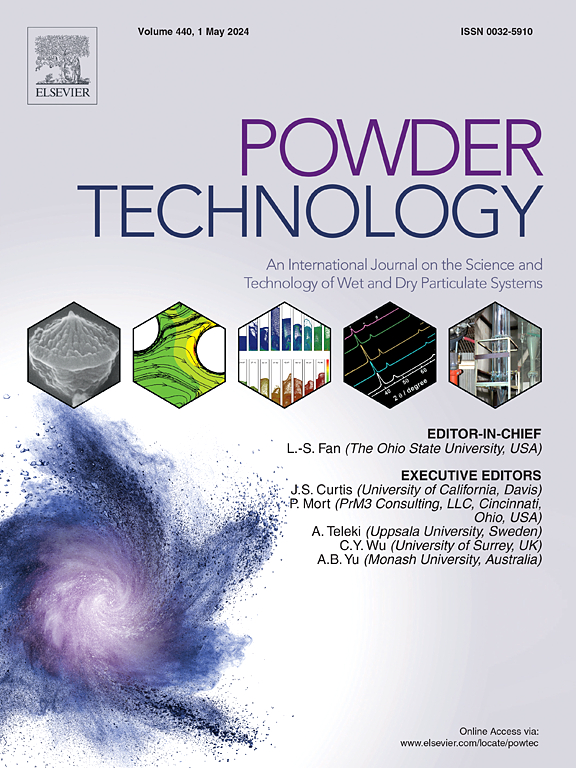新型喷流床流动特性的综合定量分析
IF 4.5
2区 工程技术
Q2 ENGINEERING, CHEMICAL
引用次数: 0
摘要
为了给新型喷淋床流场优化设计提供定量依据,本研究重点对气固流场进行了定量分析。统计比较了传统喷流床与新型喷流床流场的非均质性,评价了组合加固构件对喷流床流场的调节效果。研究表明,在相同工况下,与CSB相比,旋转叶片与多喷嘴组合的射流床(ASBMN)和旋转叶片与多喷嘴组合的射流床(ASBSN)的平均射流直径分别增大了21.3%和30.5%,死区体积分数分别减小了5.7%和5.9%。这表明复合增强构件可以有效地扩大气固接触面积,同时减小颗粒流动死区。此外,这些成分不断刺激径向气固滑移,维持径向扰动强度,增强气体脉动和涡旋强度。同时,它们可以提高喷淋床内气固径向速度的协同作用,降低锥形区域颗粒的流动阻力,增加颗粒循环通量,提高颗粒速度场的均匀性。上述研究结果为锥形-圆柱喷流床的结构参数设计与优化提供了理论参考。本文章由计算机程序翻译,如有差异,请以英文原文为准。

Comprehensive quantitative analysis of flow characteristics in novel spouted beds
To provide quantitative basis for optimizing the flow field design of novel spouted beds, this study focuses on the quantitative analysis of the gas-solid flow field. It statistically compares the heterogeneity of the flow field between the conventional spouted bed (CSB) and novel spouted beds, and evaluates the effectiveness of combined reinforcement components in regulating the flow field in the spouted bed. The study shows that under the same operating conditions, compared to CSB, the average jet diameter of the spouted bed with a combination of a swirling blade and a multiple nozzle (ASBMN) and the spouted bed with a combination of a swirling blade and a swirling nozzle (ASBSN) increased by 21.3 % and 30.5 %, respectively, while the volume fraction of dead zones decreased by 5.7 % and 5.9 %, respectively. This indicates that combined reinforcement components can effectively enlarge the gas-solid contact area while reducing particle flow dead zones. Furthermore, these components continuously stimulate radial gas-solid slip, maintain radial disturbance intensity, and enhance gas pulsation and vortex strength. Meanwhile, they can improve the synergy of gas-solid radial velocities in the spouted bed, reduce the flow resistance of particles in the conical region, increase the particle circulation flux, and improve the uniformity of the particle velocity field. The above research results provide theoretical reference for the structural parameter design and optimization of conical-cylindrical spouted beds.
求助全文
通过发布文献求助,成功后即可免费获取论文全文。
去求助
来源期刊

Powder Technology
工程技术-工程:化工
CiteScore
9.90
自引率
15.40%
发文量
1047
审稿时长
46 days
期刊介绍:
Powder Technology is an International Journal on the Science and Technology of Wet and Dry Particulate Systems. Powder Technology publishes papers on all aspects of the formation of particles and their characterisation and on the study of systems containing particulate solids. No limitation is imposed on the size of the particles, which may range from nanometre scale, as in pigments or aerosols, to that of mined or quarried materials. The following list of topics is not intended to be comprehensive, but rather to indicate typical subjects which fall within the scope of the journal's interests:
Formation and synthesis of particles by precipitation and other methods.
Modification of particles by agglomeration, coating, comminution and attrition.
Characterisation of the size, shape, surface area, pore structure and strength of particles and agglomerates (including the origins and effects of inter particle forces).
Packing, failure, flow and permeability of assemblies of particles.
Particle-particle interactions and suspension rheology.
Handling and processing operations such as slurry flow, fluidization, pneumatic conveying.
Interactions between particles and their environment, including delivery of particulate products to the body.
Applications of particle technology in production of pharmaceuticals, chemicals, foods, pigments, structural, and functional materials and in environmental and energy related matters.
For materials-oriented contributions we are looking for articles revealing the effect of particle/powder characteristics (size, morphology and composition, in that order) on material performance or functionality and, ideally, comparison to any industrial standard.
 求助内容:
求助内容: 应助结果提醒方式:
应助结果提醒方式:


